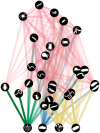Shared community history strengthens plant diversity effects on below-ground multitrophic functioning
- PMID: 39887967
- PMCID: PMC11962227
- DOI: 10.1111/1365-2656.14241
Shared community history strengthens plant diversity effects on below-ground multitrophic functioning
Abstract
The relationship of plant diversity and several ecosystem functions strengthens over time. This suggests that the restructuring of biotic interactions in the process of a community's assembly and the associated changes in function differ between species-rich and species-poor communities. An important component of these changes is the feedback between plant and soil community history. In this study, we examined the interactive effects of plant richness and community history on the trophic functions of the soil fauna community. We hypothesized that experimental removal of either soil or plant community history would diminish the positive effects of plant richness on the multitrophic functions of the soil food web, compared to mature communities. We tested this hypothesis in a long-term grassland biodiversity experiment by comparing plots across three treatments (without plant history, without plant and soil history, controls with ~20 years of plot-specific community history). We found that the relationship between plant richness and below-ground multitrophic functionality is indeed stronger in communities with shared plant and soil community history. Our findings indicate that anthropogenic disturbance can impact the functioning of the soil community through the loss of plant species but also by preventing feedbacks that develop in the process of community assembly.
Keywords: below‐ground; community assembly; community history; detritivory; food webs; herbivory; predation; soil fauna communities.
© 2025 The Author(s). Journal of Animal Ecology published by John Wiley & Sons Ltd on behalf of British Ecological Society.
Conflict of interest statement
The authors declare that they have no conflicts of interest.
Figures



References
-
- Agrawal, A. A. (2001). Phenotypic plasticity in the interactions and evolution of species. Science, 294, 321–326. - PubMed
-
- Albert, G. , Gauzens, B. , Loreau, M. , Wang, S. , & Brose, U. (2022). The hidden role of multi‐trophic interactions in driving diversity–productivity relationships. Ecology Letters, 25, 405–415. - PubMed
-
- Albracht, C. , Solbach, M. D. , Hennecke, J. , Bassi, L. , Van Der Ploeg, G. R. , Eisenhauer, N. , Weigelt, A. , Buscot, F. , & Heintz‐Buschart, A. (2024). Common soil history is more important than plant history for arbuscular mycorrhizal community assembly in an experimental grassland diversity gradient. Biology and Fertility of Soils, 60, 547–562.
-
- Amarasekare, P. (2008). Spatial dynamics of foodwebs. Annual Review of Ecology, Evolution, and Systematics, 39, 479–500.
-
- Amyntas, A. , Berti, E. , Gauzens, B. , Albert, G. , Yu, W. , Werner, A. S. , Eisenhauer, N. , & Brose, U. (2023). Niche complementarity among plants and animals can alter the biodiversity–ecosystem functioning relationship. Functional Ecology, 37, 2652–2665.
Publication types
MeSH terms
Substances
Grants and funding
LinkOut - more resources
Full Text Sources

